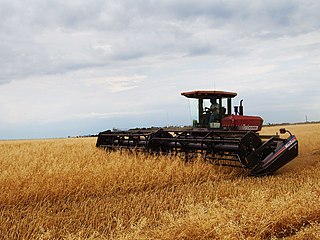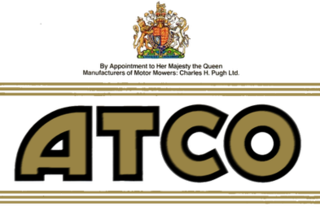Edwin Beard Budding, an engineer from Eastington, Stroud, was the English inventor of the lawnmower (1830) and adjustable spanner (1842).

The modern combined harvester, or simply combine, is a versatile machine designed to efficiently harvest a variety of grain crops. The name derives from its combining four separate harvesting operations—reaping, threshing, gathering, and winnowing—into a single process. Among the crops harvested with a combine are wheat, rice, oats, rye, barley, corn (maize), sorghum, soybeans, flax (linseed), sunflowers and rapeseed. The separated straw, left lying on the field, comprises the stems and any remaining leaves of the crop with limited nutrients left in it: the straw is then either chopped, spread on the field and ploughed back in or baled for bedding and limited-feed for livestock.

A lawn mower is a machine utilizing one or more revolving blades to cut a grass surface to an even height. The height of the cut grass may be fixed by the design of the mower, but generally is adjustable by the operator, typically by a single master lever, or by a lever or nut and bolt on each of the machine's wheels. The blades may be powered by manual force, with wheels mechanically connected to the cutting blades so that when the mower is pushed forward, the blades spin or the machine may have a battery-powered or plug-in electric motor. The most common self-contained power source for lawn mowers is a small internal combustion engine. Smaller mowers often lack any form of propulsion, requiring human power to move over a surface; "walk-behind" mowers are self-propelled, requiring a human only to walk behind and guide them. Larger lawn mowers are usually either self-propelled "walk-behind" types or more often, are "ride-on" mowers, equipped so the operator can ride on the mower and control it. A robotic lawn mower is designed to operate either entirely on its own or less commonly by an operator by remote control.

A mower is a person or machine that cuts (mows) grass or other plants that grow on the ground. Usually mowing is distinguished from reaping, which uses similar implements, but is the traditional term for harvesting grain crops, e.g. with reapers and combines.

A baler or hay baler is a piece of farm machinery used to compress a cut and raked crop into compact bales that are easy to handle, transport, and store. Often, bales are configured to dry and preserve some intrinsic value of the plants bundled. Different types of balers are commonly used, each producing a different type of bale – rectangular or cylindrical, of various sizes, bound with twine, strapping, netting, or wire.

The Ferguson-Brown Company was a British agricultural machinery company formed by Harry Ferguson in partnership with David Brown.

A swather, or windrower, is a farm implement that cuts hay or small grain crops and forms them into a windrow. "Swather" is predominantly the North American term for these machines. In Australia and other parts of the world, they are called "windrowers". They aid harvesting by speeding up the process of drying the crop down to a moisture content suitable for harvesting and storage.

A cultivator is an agricultural equipment used for secondary tillage. One sense of the name refers to frames with teeth that pierce the soil as they are dragged through it linearly. Another sense refers to machines that use rotary motion of disks or teeth to accomplish a similar result. The rotary tiller is a principal example.

The Claas Cougar is a self-propelled mower produced by the German agricultural machinery manufacturer Claas. The mower, which is named after the cougar, a large American cat, was first presented in 2003. Due to its maximum cutting width of 14 metres (46 ft) it is classified as the largest self-propelled mower in the world.
A conditioner is a farm implement that crimps and crushes newly cut hay to promote faster and more even drying. Drying the hay efficiently is most important for first cutting of the hay crop, which consists of coarse stalks that take a longer period of time to draw out moisture than finer-textured hays, such as second and subsequent cuttings.

A brush hog or "bush hog" is a type of rotary mower. Typically these mowers attach to the back of a farm tractor using the three-point hitch and are driven via the power take-off (PTO). It has blades that are not rigidly attached to the drive like a lawnmower blade, but are on hinges so if the blade hits a rock or stump, it bounces backward and inward, and then centrifugal force makes it go outwards again.

Thomas Green & Son, Ltd. were engineers who manufactured a wide range of products at the Smithfield Foundry, Leeds, United Kingdom

Eicher tractor was a manufacturer of tractors, agricultural machinery and engines. The company was founded in 1936 by the brothers Josef and Albert Eicher in the Upper Bavaria town of Forstern. The brand name "Eicher" was last used in Europe in 2009 by the Dutch agricultural machinery dealer Hissink & Zonen and is still in use today in India at Eicher Goodearth which manufactures tractors & commercial vehicles by this name.

Two-wheel tractor or walking tractor are generic terms understood in the US and in parts of Europe to represent a single-axle tractor, which is a tractor with one axle, self-powered and self-propelled, which can pull and power various farm implements such as a trailer, cultivator or harrow, a plough, or various seeders and harvesters. The operator usually walks behind it or rides the implement being towed. Similar terms are mistakenly applied to the household rotary tiller or power tiller; although these may be wheeled and/or self-propelled, they are not tailored for towing implements. A two-wheeled tractor specializes in pulling any of numerous types of implements, whereas rotary tillers specialize in soil tillage with their dedicated digging tools. This article concerns two-wheeled tractors as distinguished from such tillers.

A flail mower is a type of powered garden/agricultural equipment which is used to deal with heavier grass/scrub which a normal lawn mower could not cope with. Some smaller models are self-powered, but many are PTO driven implements, which can attach to the three-point hitches found on the rear of most tractors. This type of mower is best used to provide a rough cut to long grass and even brambles, where contact with loose debris may be possible such as roadsides.

Sensation Lawn Mowers was a commercial lawnmower brand created by Howard Phelps in 1944. The Sensation Lawn Mower Company was located in Ralston, Nebraska, USA.

Atco Limited was a British mower company which traded as "Atco Ltd" from 1981 to 1990, making lawn mowers and garden tools. It sold a range of lawn mowers including lawn and garden tractors.
Mower blades are the cutting components of lawn mowers. They are usually made of sturdy metals as they must be able to withstand high-speed contact with a variety of objects in addition to grass. The materials used vary by manufacturer.
Trimax Mowing Systems is a New Zealand-based manufacturer of professional turf maintenance equipment. Trimax designs, develops, builds and markets high quality roller mowers with flail or rotary blade systems. The company's headquarters are located in Tauranga, New Zealand.

The Porsche-Diesel Standard 218, also known as N 218, is the third generation of the two-cylinder Standard tractor series, manufactured by Porsche-Diesel Motorenbau GmbH in Friedrichshafen am Bodensee. The Standard 218 was produced in four different variations. It succeeded its predecessor, the Porsche-Diesel 208 in 1957. In total, the Porsche plant produced more than 12,000 Standard 218 tractors from 1957 to 1963.
















